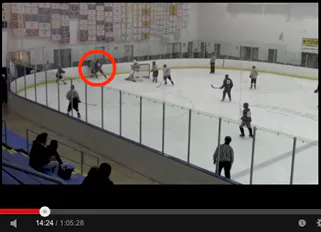RinkTalk

Project description
Hockey coaches like to show their players game film in order to teach them important lessons about their play. The more players watch film of themselves playing, the faster they will improve. However, it’s difficult for a coach to make enough time to show a significant amount of game film to players over the course of a season -- especially below the college level. One reason for this is that before holding a film session, a coach first must watch an entire game to find teachable moments. This takes at least as much time as the game itself, which can lead to a coach spending well over an hour reviewing film of one game before he can present his findings to players.
One current way of providing a coach information is to have parents write down statistics on paper, such as the location on ice of hits and shots, and the number of shots per period. However, this solution does not let a coach know where in game film these events happened. Players can learn far more from watching game film than from reading a statistics sheet.
We introduce RinkTalk, an iOS application that lets spectators effortlessly record the times of events during a game. A spectator, usually a parent, double-taps their screen when something happens to record the time of that event. The spectator receives haptic and visual feedback that the event time has been received. We aggregate all spectators’ recordings to ensure a balance of coverage and accuracy. A coach receives a list of time markers in the description of a Youtube video of a game, allowing them to navigate and easily review important occurrences in a game. The main conceptual contribution of RinkTalk is that spectators at a live event can record information in real time, without being distracted from enjoying the event.
When designing the application, we needed to ensure this issue was addressed and prioritized. We give the spectator a full-screen target to double-tap. When a spectator successfully makes a recording, the phone briefly vibrates and the screen flashes bright green. These design decisions allow a spectator to use the application without looking at their phone. A spectator feels the vibration and sees the green flash in their peripherals, so they do not need to check the application to confirm they have succeeded. From our survey following tests at live games, parents agreed that the app did not interfere with their enjoyment of watching the game and their child.
We completed a user study for RinkTalk, testing our application at two high school hockey games. In one game, we asked spectators to record hits. In the other, we asked them to record faceoffs, goals, and penalties. We measured qualitative success by asking spectators about their experience during the game with the app. Spectators agreed that they would use the app again at another game, as they felt they were helping their team by recording events. We measured quantitative success by the accuracy and coverage of spectators’ recordings of events. After we watched film of both games and determined the ground truth for all events, we found that spectators achieved high accuracy and coverage for goals, penalties, and faceoffs, but struggled with hits, which are much more ambiguous. After sending a notated YouTube video of the second game to the coach, he was able to tell us insights he gained about how his team needs to improve faceoffs, and what mistakes led to goals against his team.
Publications
Team
Masters and Undergraduate Students
- Alumni: Frank Avino
- Alumni: Henry Spindell